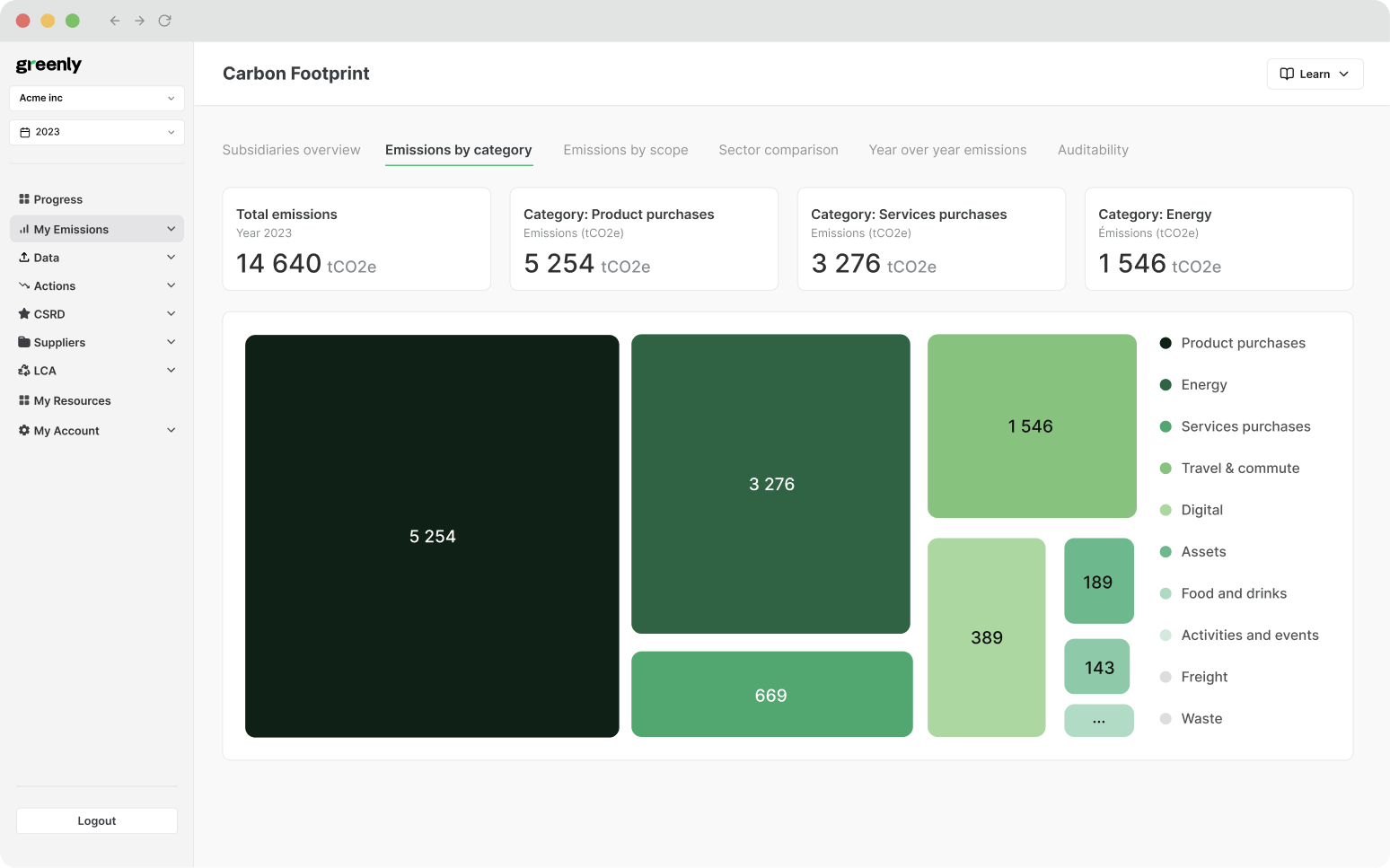
Sustainable Development Goals (SDGs): All You Need to Know
The United Nations has defined 17 goals, aimed at creating a better world. What are these so-called "Sustainable Development Goals" ? Explanations.
ESG / CSR
Industries



When choosing where to live, even within the United States – many may filter their preferences based on the type of natural disaster or extreme weather events that occur in that state: such as hurricanes, a supercell thunderstorm, earthquakes, or where in the world may produce tornadoes.
Tornadoes can cause catastrophic damage to homes in the Midwest of the United States, but how many tornado outbreaks and violent tornadoes are caused or aggravated by climate change itself?
In this article, we’ll discuss how tornadoes happen, where they are most likely to occur, and how climate change impacts the frequency and severity of tornadoes.
A tornado is a narrow, rapidly rotating tunnel of air that occurs when a thunderstorm extends to the ground. A tornado is like a strong, but invisible wind – but sometimes, tornadoes can be seen from far away due to collecting dust and debris. If tornadoes are to be seen, they will appear dark gray in color.
Out of all the different atmospheric storms, tornadoes are known to be the most violent and terrifying of them all – as they usually set out to destroy anything and everything in their wake.
Tornadoes occur all over the world, including almost all seven continents – from Europe, Australia, Africa, Asia, and North or South America. Specifically in the U.S. – tornadoes usually occur in the Midwest or southern states, and are most common in Texas, Nebraska, and Kansas.
However, states like Mississippi and Alabama are by no means tornado free: having experienced some of the worst tornadoes for the United States in 2022. On average, around 1,200 tornadoes hit the U.S. every year, but since tornado records are only dated 1950 and beyond – it’s fair to say that the annual tornado occurrence rate may be higher than we think.
The region in which tornadoes are most likely to occur is known as “tornado alley” – but tornadoes are still likely to occur outside of this likely area, and can still cause severe weather events an damage. For instance, tornadoes can occur in the southeastern part of the U.S. and even the central Plains depending on the time of year.
The summary cards below will reveal some of the states in the U.S. most likely to be impacted by severe thunderstorms and tornado safety:
Part of “Tornado Alley,” Oklahoma regularly experiences destructive tornadoes, especially in spring and early summer. Severe thunderstorms are common throughout the season.
Located at the heart of Tornado Alley, Kansas is vulnerable to strong tornadoes that can damage farmland, homes, and local infrastructure during storm season.
Though not traditionally part of Tornado Alley, Tennessee has seen an uptick in tornado activity in recent years, particularly in urban and suburban areas.
In addition to hurricanes, Florida also sees tornadoes, especially when tropical storms make landfall. Thunderstorms in the state can escalate rapidly during summer months.
Tornado alley refers to the areas in the United States where tornadoes happen most frequently, but “tornado alley” is often distinguished in a multitude of ways: such as by how many tornadoes have occurred in that area each year, the strength of tornadoes, and the length of the tornadoes.
However, tornado alley usually most commonly refers to the central part of the United States – or better known as the Midwest.
Did you know? Many people from the Midwest in the U.S. will refer to tornadoes as a, “twister”!
According to the National Weather Service, tornadoes usually happen during set seasons, depending on the region in the United States they occur.
The flip cards (move cursor over card to flip) will reveal when tornadoes are mostly likely to occur in various regions across the U.S.:
While most tornadoes happen in the late afternoon or into the early evening, tornadoes can still occur anywhere at any time.
Yes, tornadoes are considered as extreme weather events due to their high wind speed, severe storms, and how strong tornadoes cause extensive damage to schools, residences, and even mobile homes.
In fact, tornadoes have been a massive issue in the United States – as in early 2024, Omaha, Nebraska, southern Oklahoma, Iowa, and even parts of Texas – with surface winds reaching a whopping 170 mph and even resulted in 3 casualties. There were an alarming amount of tornadoes occurring in the United States during April 2024, totaling at 105 tornadoes.
As of 2024 alone, the United States has suffered from 639 tornadoes – meaning that thousands are left grieving their homes, communities, and even people. These areas weren't only hit by the tornadoes, but were left subject to subsequent flooding.
Besides the United States, two areas of the world which are most prone to disastrous tornadoes include Argentina and Bangladesh.
The summary cards below will reveal how a tornado threatens countries like Argentina and Bangladesh:
Tornadoes in Argentina, particularly in the Pampas region, can cause significant destruction to homes and agriculture. The country experiences one of the highest tornado frequencies outside the U.S., often resulting in crop losses and displaced rural communities.
Although not as frequent, tornadoes in Bangladesh are often deadly due to high population density and vulnerable infrastructure. The 1989 Daulatpur–Saturia tornado remains one of the deadliest in recorded history, highlighting the region’s risk.
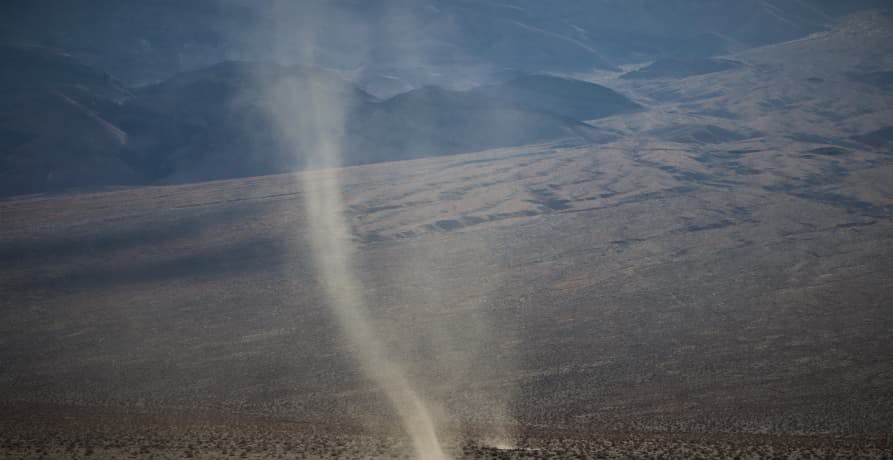
Unlike Dorothy in the Wizard of Oz, a tornado's presence doesn't come out of no where – as tornado strength and even smaller tornadoes are developed over a time period and sequence of events.
According to Penn State University, tornadoes form when specific atmospheric conditions create the environment for a perfect storm environment, starting with extreme heat at the surface that causes warm air to rise rapidly into the atmosphere.
This process occurs when there is tangible atmospheric instability, such as when there are sharp temperature differences between the ground and higher altitudes. On the day when a tornado occurs, temperatures can decrease as a tornado grows in height by nearly 30°F per mile for several miles. This aids in the creation of the unstable conditions needed for a severe thunderstorm to take place.
As the warm air rises, it encounters varying wind speeds at different altitudes, a phenomenon called wind shear – combination of instability and wind shear provides the energy and rotation needed for tornado formation.
A visible tornado will begin to emerge to the human eye as a funnel cloud that descends from the storm when rotating air within the thunderstorm intensifies into a violently rotating column. Both rising, spinning, warm air and sinking cool air are integral to a tornado maintaining its structure and power. The wind speed within these rotating columns can reach extraordinary velocities, creating the destructive character we associate with tornadoes.
When the funnel cloud touches the ground, it officially becomes a tornado, with the violently rotating column of air extending from the storm cloud to the earth's surface, capable of causing significant damage as it moves across the landscape.
The timeline below will further illustrate how tornadoes are formed: use keywords such as wind direction, air extending, rotating column of air, unstable atmosphere, water droplets, dry air, wall cloud, extreme heat:
Intense surface heating creates the unstable atmosphere necessary for tornado development.
Warm, moist air near the ground meets cold, dry air aloft, forming instability in the atmosphere.
Wind blowing at different speeds and directions with height initiates wind shear, a key tornado ingredient.
Wind shear causes horizontal tubes of air to rotate, which can be tilted vertically by updrafts.
Powerful updrafts stretch the rotating air upward, tightening the spin like a figure skater pulling in arms.
Lowered cloud base forms beneath the thunderstorm; it may rotate and indicate tornado formation.
Water condenses in the funnel as dry air wraps around, forming the visible tornado.
While climate change has been known to aggravate other types of natural disasters, there isn’t as much science to prove that climate change is having a significant impact on tornadoes – although scientists predict that climate change could have an impact on the frequency and severity of tornadoes and other natural disasters in the future.
However, that being said, one thing that climate change is doing is pushing cold or warm air elsewhere – which is what is causing abnormal weather conditions in other areas of the United States, such as last winter’s unusual snowstorm. Therefore, some evidence may imply that rising temperatures could be contributing to more tornadoes in the future – seeing as most tornadoes occur in late spring and summer. In addition to this, “tornado alley” may be pushed further east towards the southeastern states (already susceptible to hurricanes) due to climate change pushing air in new directions.
This is because the most dangerous tornadoes are formed when warm and moist air combine, creating a “wind shear” that can aid in tornado formation. Climate change is not only raising the temperature and moisture of the air outside, but is causing lakes to dry up – which leave behind toxic particles and debris. The combination of rising, moist temperatures with increased leftover debris laying on the ground isn’t a good equation for preventing more frequent and deleterious tornadoes.
That being said, tornadoes are still spontaneous in nature – and the raise in global temperatures and air moisture isn’t something that should be ignored. In fact, tornadoes are more likely to occur when there is a combination of wind and thunderstorms, and studies from Stanford and Purdue have shown that a drop in wind shear is more likely to decrease on clear days. Therefore, the concept of climate change aggravating tornadoes is still backed up by the other science that has been found.
However, the good news is that while there’s been an increase in warm, moist air in the midst of climate change, there has been a decrease in wind shear – which is expected to continue on a downwards trajectory. This is an argument to be made that climate change could actually result in less tornadoes in the coming years.
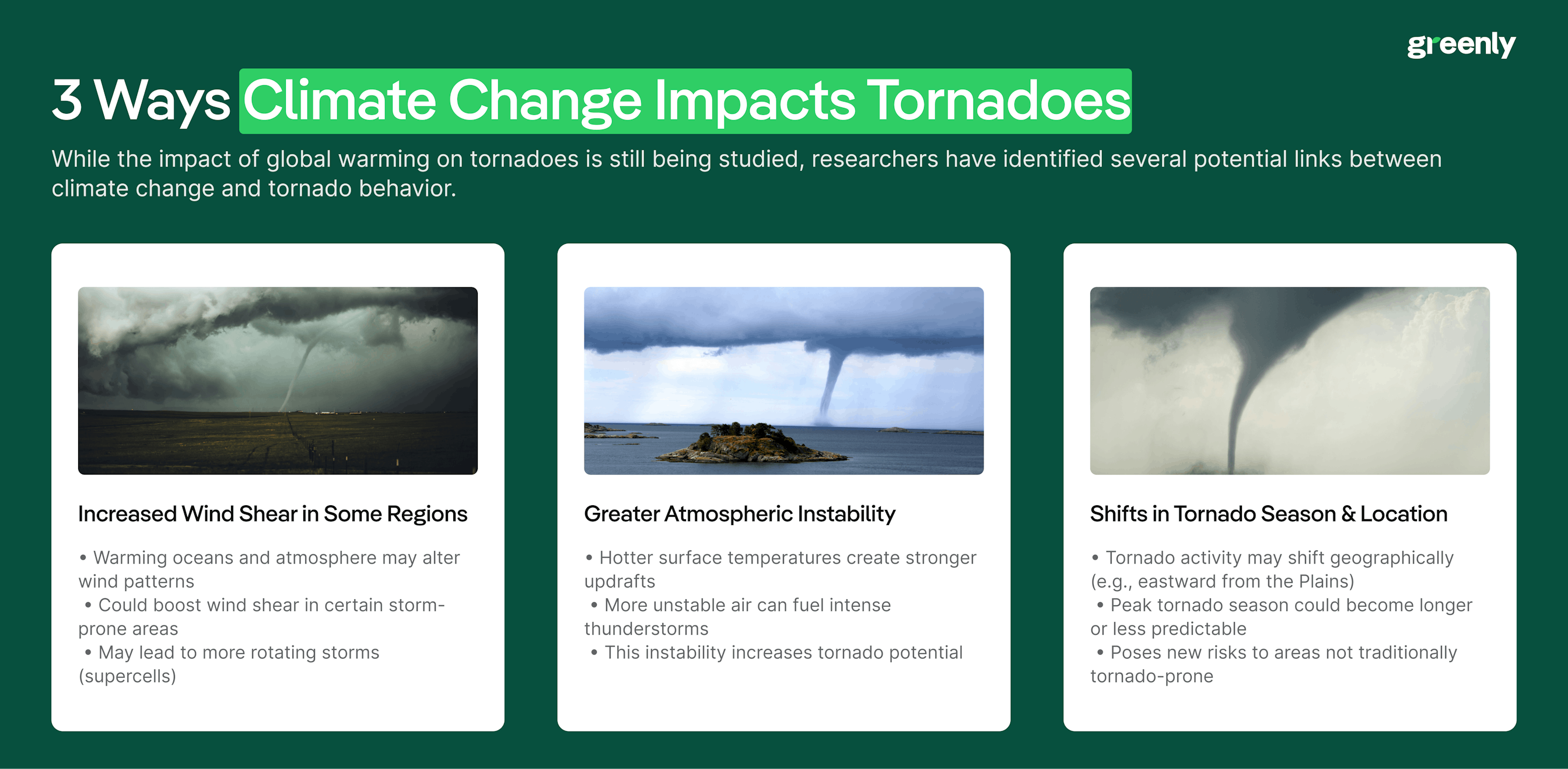

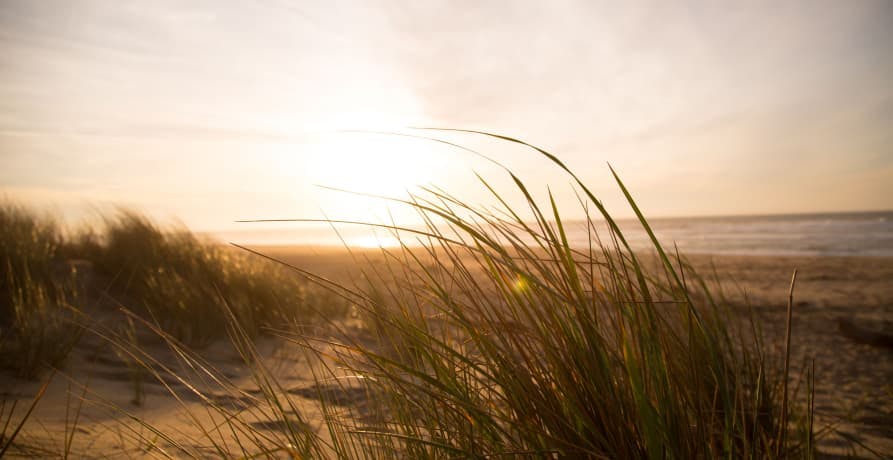
Tornadoes impact society as they cause flying debris, which in turn – provokes profound damage to our residences and personal belongings, which can take a toll on eco-anxiety and our mental well-being.
It’s probable to believe that tornadoes could be more frequent and deadly as climate change continues to get out of control, and therefore – it’s important to understand the impact of tornadoes not just on climate change, but on how they affect society.
Tornadoes can cause some of the most destructive damage to houses, which puts a financial strain on both homeowners and insurance companies. Natural disasters like tornadoes can leave people homeless, and even impact other imperative facts of American society – such as paying your taxes on time.
In addition to creating a financial burden for an already suffering insurance industry, tornadoes can have other significant long-term impacts. For instance, tornadoes can destroy college campuses and other school buildings and disrupt education. Natural disasters like tornadoes require massive resources and time in order to rebuild what tornadoes have destroyed – which can take away from other areas that would’ve received financial aid otherwise: such as for the homeless, food shelters, or non profit organizations seeking to fight against climate change
The Joplin tornado in Missouri was so extreme, that it destroyed thousands of residences and businesses in the blink of an eye – which resulted in high rates of unemployment and the loss of basic utilities and resources as trees and power lines were demolished by the infamous tornado.
The flip cards (move cursor over card to flip) below will reveal additional ways in which the Joplin Tornado affected society:
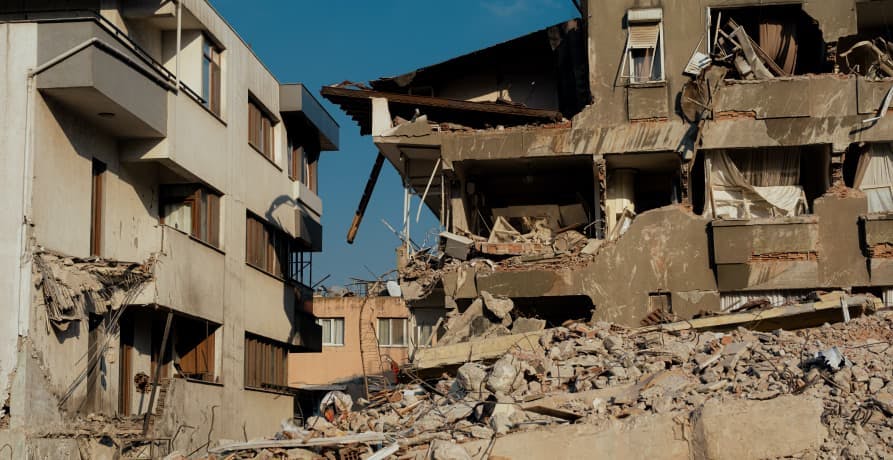
We can't entirely prevent the impact of any natural disasters, including tornadoes – but we can improve our climate resilience and resource availability to help ensure that areas susceptible to tornadoes.
Here are some ways we can prevent the negative impact of tornadoes in the long-term:
Scientists are still seeking to learn more about tornadoes, meaning that one of the best ways to prevent a tornado from destroying our susceptible communities is by investing in research to better learn how tornadoes are formed and develop a better understanding of how climate change is impacting tornadoes.
Another way to prevent the impact of tornadoes would be to ensure that buildings are up to code, and to ensure that all buildings have a shelter and sufficient ways to communicate with the outside world in the midst of a storm. States that are most vulnerable to tornadoes should rely on their local governments to carefully plan land-use, such as by avoiding construction in areas where tornadoes could “swoop” up nearby debris or materials, or areas subject to flooding. Precautions like these can help to minimize the impact of tornadoes.
Overall, community preparedness and general education on safety if a tornado is to hit is imperative for states vulnerable to tornadoes.
However, if a tornado is already on its way – there is only one thing left to do, and that’s to send out a message for a tornado watch or a tornado warning.
A Tornado Watch is issued when meteorologists who study weather patterns across the U.S. predict that a tornado is likely to occur – especially in the midst of other severe weather, like thunderstorms. A tornado watch usually encompasses several areas or even multiple states, and when a tornado watch is issued – it’s recommended that those in areas subject to potential tornadoes keep posted to find out if an official tornado warning is issued.
A Tornado Warning is issued when a tornado has already been spotted or indicated on radars used by meteorologists. A tornado warning is an official directive order to seek immediate shelter, and that the approaching tornado could cause catastrophic damage to your home or even harm you or your loved ones. Similar to a tornado watch, a tornado warning can occur across multiple states – but a tornado warning is ultimately more severe and imminent than a tornado watch.
The battle cards below will further breakdown the differences between a tornado watch and a tornado warning:
Clearly, tornadoes require utmost attention and preparedness amongst those who reside in tornado-prone areas – but is there anything people can do to prevent tornadoes from being as bad as they are in the first place?
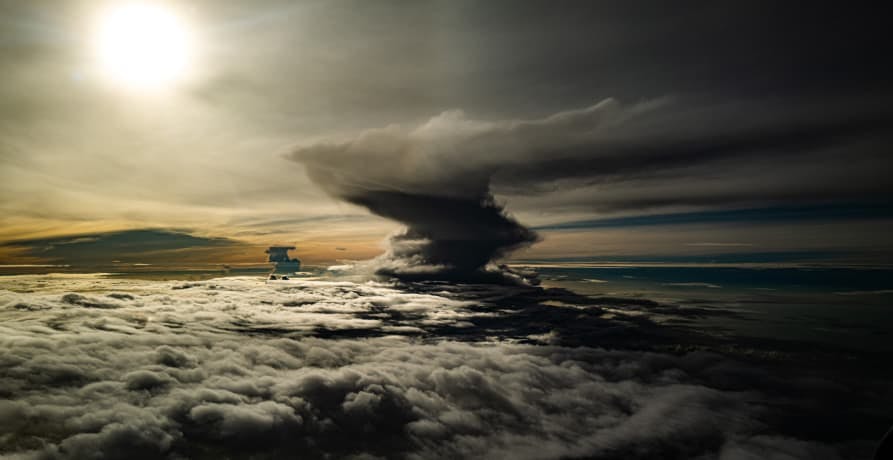
It’s hard to determine if emission reductions on a global (or even national) scale would have an impact on the severity and frequency of tornadoes, but seeing as science has inferred that it isn’t illogical to link the shift in tornado alley to climate change – it wouldn’t be out of the question to presume that a world where climate change isn’t our most pivotal problem could lead to less extreme weather: including tornadoes.
However, there is no proof yet that fighting against climate change could help to stop tornadoes – as scientists are still learning about tornadoes every day.
Ultimately, communities can take several steps to prepare themselves for tornadoes, but science is not strong enough yet to determine if fighting against climate change itself can prevent worse tornadoes.
Natural disasters, tornadoes especially, are scary – but so is climate change, and there’s no harm in fighting two battles at the same time to see if we can kill two birds with one stone.
If reading this article about tornadoes has made you interested in reducing your carbon emissions to further fight against climate change – Greenly can help you!
Tornadoes are just one of the many surprising things to occur in the midst of climate change, but don’t worry – Greenly is here to help. Book a demo with one of our specialists to learn more.
Greenly can help you make an environmental change for the better, starting with a carbon footprint assessment to know how much carbon emissions your company produces.
